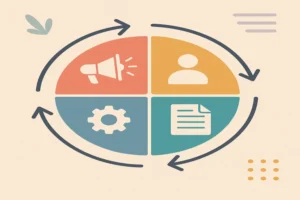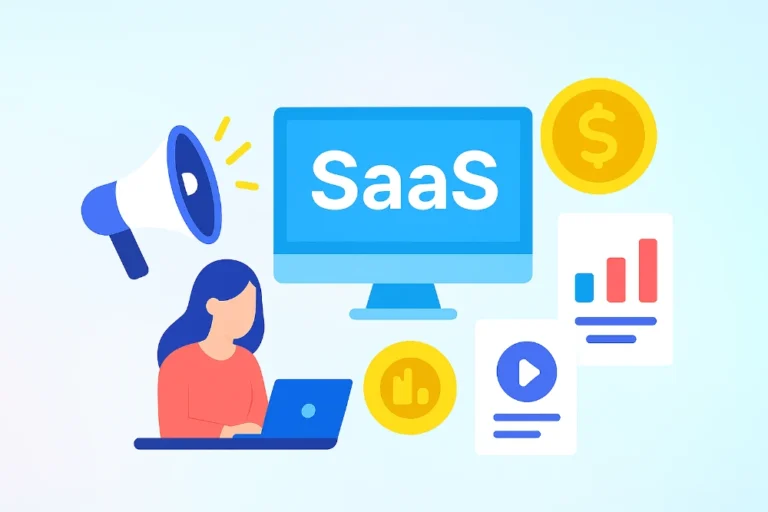When it comes to B2B SaaS, content is not merely a means of filling your blog or creating a social media post. It is the base of your visibility, the voice of your brand, and an unstoppable engine that fuels long-term customer growth.
With complicated buying processes and extremely knowledgeable decision-makers, SaaS businesses require more than excellent writing. They need an intelligent, targeted content strategy that addresses every step of the customer journey.
This guide provides a detailed explanation of how to develop an effective content strategy for B2B SaaS, regardless of your business’s specific activities.
Why Content is Essential in B2B SaaS Marketing

During the initial days of SaaS marketing, a handful of product pages and a basic blog would suffice. Nowadays, it is different. Buyers want to find solutions on their own. They seek comparisons, use cases, expert views, and customer testimonials before even scheduling a demo.
Good content enables your business to be a part of that research process. It allows you to respond to questions, demonstrate expertise, and build confidence with potential customers. And since SaaS products change rapidly, content serves as a reliable guide that enables users to stay informed and engaged.
Understand Your Audience and How They Buy
B2B SaaS customers are often members of a larger buying team. One may care about a technical feature, another about price, and another about integration or security. A good strategy addresses all of these concerns in a practical, non-sales manner.
Begin by outlining your audience. Understand what they’re looking for, where they’re having trouble, and what taps into their interest in a solution like yours. From there, they create content that complements every step of their journey, from initial awareness to long-term customer achievement.
Core Components of a Sound Content Strategy

A strategy without organization is a shot in the dark. These are the essential building blocks of a solid B2B SaaS content base:
- Concise objectives: Are you attempting to drive traffic, create leads, get users to use features, or grow retention? Establish content objectives for every stage.
- Identify your target customer segment and buyer personas. Produce content for various industries, job functions, and user requirements.
- Funnel alignment: Develop varied content for initial research, product consideration, and post-signup engagement.
- Brand voice: Ensure that the tone of your content sounds trustworthy, helpful, and cohesive across all your platforms.
- Planning and systems: Utilize content calendars, documentation, and workflows to maintain consistency and productivity.
A well-considered structure not only saves time but also ensures that each piece of content has a clear purpose.
Types of Content That Deliver Results in SaaS
Not all content has to sell something. The most effective SaaS content teaches, informs, and enables actual decisions. Below are some of the remarkably effective formats:
- Educational blog posts: Answering specific issues or defining fundamental subjects your audience looks for.
- Product tutorials and onboarding guides: Get users up and running on your platform as quickly as possible, thereby reducing support requests.
- Case studies and success stories: Illustrate how actual businesses have gained an advantage from your product.
- Video demos and walkthroughs: Make features tangible and help prospects envision solutions.
- Downloadable resources and templates: Provide solutions that make the user’s work simpler and place your product within their workflow.
- Email sequences: Engage leads, onboard users, and remind your product of existing importance.
Connect Content with Product and Sales Teams
Most effective content tactics aren’t developed in silos. They are done in collaboration with teams.
Sales teams can pass along what prospects inquire about during calls. Product teams might assist in breaking down new features and roadmap announcements. Support teams can identify frequent customer pain points. Use this feedback to inform your content calendar.
When everyone collaborates, your content is no longer just marketing; it becomes a powerful tool for engagement. It’s a strong source of trust, clarity, and value for your audience.
How to Know If Your Content Is Working

Measuring content is not traffic or social likes. It is measuring how your content drives users through the journey.
Monitor metrics like:
- Lead conversions from content
- Time spent on key pages
- Trial or demo signups from email or blog
- Email click and open rates
- Onboarding content with feature adoption
- Helpful resources for customer retention
Use unique tools like Google Analytics, CRM platforms, or customer journey tools to look at where content makes an impact. These will guide you on how to improve and grow steadily.
Avoid These Common Content Mistakes

Even amazing products in SaaS can lose out if their content is not aligned correctly. These are some common mistakes to watch out for:
- Writing without knowing who the content is for
- Writing about only product features rather than addressing actual issues
- Posting content without knowing how to disseminate it
- Not touching older content that requires refreshes or updates
- Content created in isolation without contribution from product, sales, or support
A solid content strategy hinges on clarity, not assumptions.
Conclusion
A B2B SaaS content marketing plan is more than a piece of paper. It is a living plan that evolves in tandem with your product, staff, and customers.
Keep your attention on your audience. Keep every bit of content useful. Keep listening to what succeeds. As time passes, this will promote deeper relationships, enhance conversions, and foster lasting client loyalty.
If your content teaches first and sells second, your brand will always be ahead of the pack.


